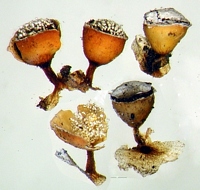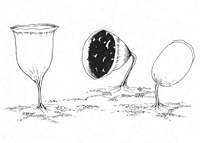|
 Craterium minutum Craterium minutum
SynonymsCraterium pedunculatum
Craterium vulgare
Peziza minuta
BiostatusPresent in region - Indigenous. Non endemic
Images (click to enlarge)
Owner: J.A. Cooper | 
Caption: Sporangia of Craterium minutum, each of which is about 1 mm tall.
Owner: S.L. Stephenson |
Article: Cooke, M.C. (1879). New Zealand fungi. Grevillea 8(46): 54-68.
Article: Stephenson, S.L. (2003). Myxomycetes of New Zealand. Fungi of New Zealand. Ngā Harore o Aotearoa 3: xiv + 238 p. Hong Kong: Fungal Diversity Press.
Description: Fruiting body a stalked (or rarely sessile) sporangium, gregarious, 0.3–1.5 mm tall. Sporotheca goblet shaped to subcylindrical, erect, 0.2–0.8 mm in diameter. Stalk usually slightly paler than the base of the cup, orange red, translucent, furrowed, one half the total height or less. Peridium thick, consisting of two layers, the outer layer cartilaginous, ochraceous brown or olivaceous to deep chocolate, umber, or bright brownish red, usually darker below, the inner layer limy and white, dehiscence by a distinct preformed operculum that is sharply separated from the rest of the peridium. Capillitium physaroid, the nodes large, irregular, white or ochraceous, tending to become aggregated at the center. Spores black in mass, violaceus brown by transmitted light, minutely warted, 8–10 µm in diameter. Plasmodium white
Habitat: Dead leaves, twigs, and sometimes wood or bark
Distribution: Probably cosmopolitan (Martin & Alexopoulos 1969). First reported from New Zealand by Cooke (1879), based on a specimen collected in Mid Canterbury. Also known from Three Kings Islands, Auckland, Waikato, Bay of Plenty, Wellington, Hawkes Bay (Colenso 1879), Mid Canterbury, South Canterbury, Dunedin (Lister & Lister 1905), and the Chatham Islands.
Notes: This is the most common species of Craterium in New Zealand. Other species of Craterium that might be encountered lack a distinct preformed operculum.
|